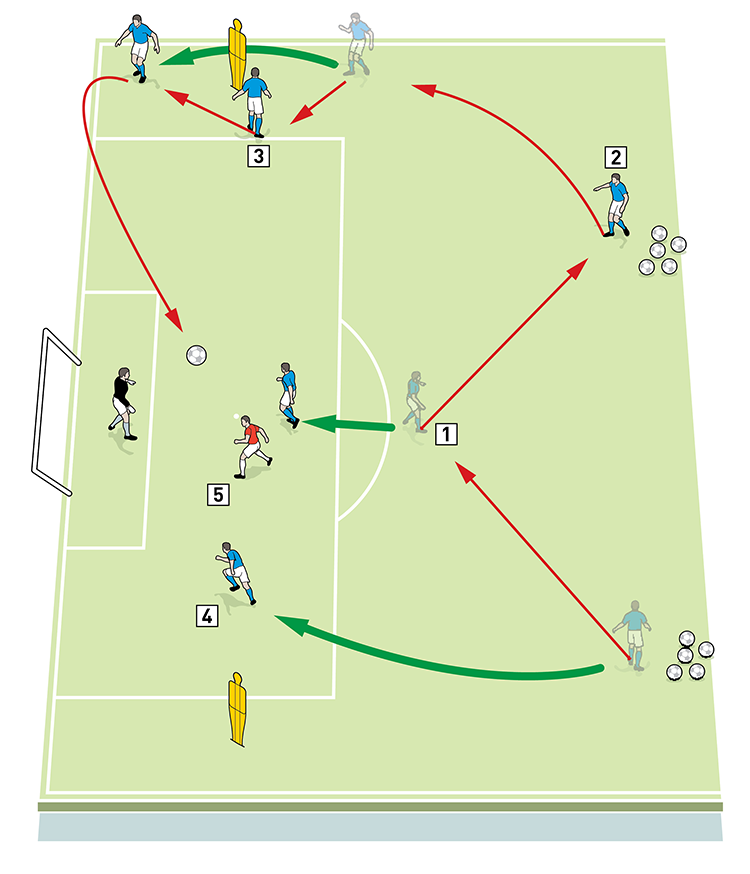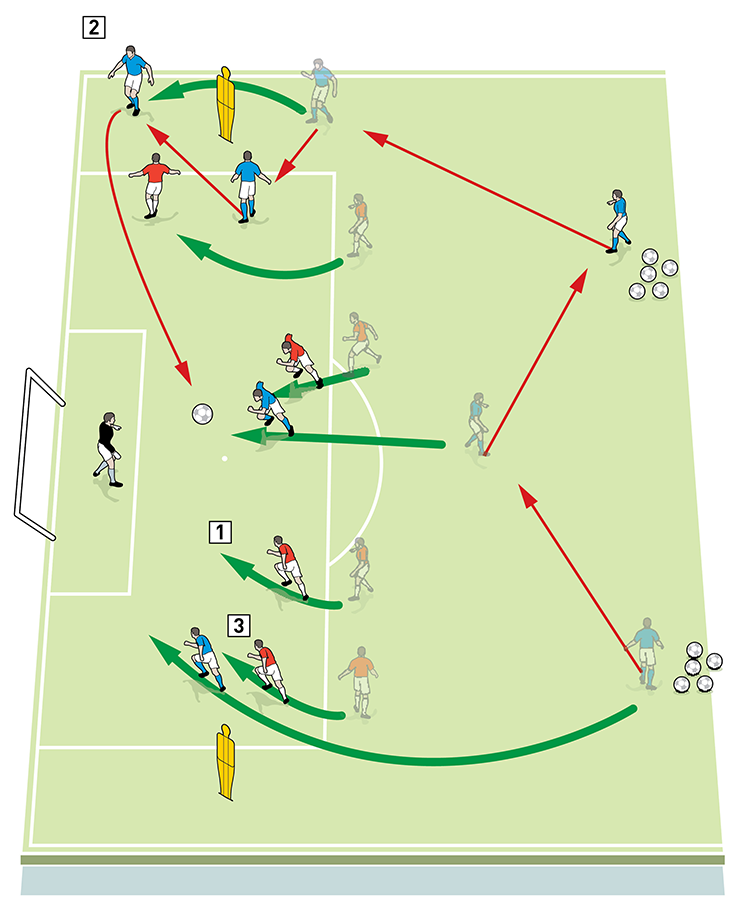You are viewing 1 of your 1 free articles
Defending crosses
Use this session to develop the decision making and positional awareness of defenders when faced with a variety of dangerous balls crossed into the penalty area.
| Area | Half a pitch |
| Equipment | Balls, bibs, cones, mannequins, 1 full size goal |
| No. of Players | Up to 9 players + 1 goalkeeper |
| Session Time | 30mins |
This session is designed to develop the decision making and positional awareness of defenders when faced with a variety of dangerous balls crossed into the penalty area.
Defenders are always asking questions of the coach, even at the highest levels of the game – and this is a session that will really get them engaged.
To one degree or another, the defenders are all physical, quick and athletic, but positional awareness and decision making has always got to be worked on and reinforced, especially when opposing teams are able to get into wide areas.
I would run this session at least every other week and perhaps more often if we’ve gone through a period of conceding extra goals from crosses.
I would also run it if different personnel are coming into our starting back four or back three.
What do I get the players to do?
Defending crosses
We set up on the final third of the pitch, with a full size goal and a goalkeeper. We’re starting with six outfield players, split into one defender and an attacking team of five. The attackers are made up of three central strikers/midfielders and two wide men, who start on the same wing, as shown [1].
Play begins with the strikers, who combine to work the ball across the pitch before passing out to one of the wide players. The two wide men play a one-two around the mannequin and then cross the ball into the penalty area. The strikers must attack the cross in pairs, while the sole defender has a decision to make – whether to read the cross and follow the flight of the ball, or to track the first and most dangerous of the strikers.
We alternate wings so the cross is delivered from different sides of the pitch.
1

2. A striker feeds one of the wide players
3. The wide pair play a one-two around the mannequin and one crosses into the area
4. Two of the strikers run into the penalty area to attack the cross
5. The sole defender is outnumbered and must decide whether to follow the flight of the ball or track the first and most dangerous striker
How do I progress the session?
Using the same basic set-up, the session develops and progresses with the addition of an extra defender. That would make it 2v2 in the penalty area when the strikers attack the cross, as shown [2].
2

2. Because it’s a 2v2 in the penalty area and the numbers are even, the red defenders can latch onto the blue attackers and track them closely
3. Here a defender is able to head the ball clear
The session can be progressed further by adding an extra striker to make it 3v2 in favour of the attackers. We make sure we allow time to talk to the defenders about body angles, communication with the goalkeeper, and making early contact with the attackers.
For the final progression, we play with a back four (or a back three and a wing back). The goal is attacked in the same manner, with crosses into the penalty area for the attacking pair, as shown [3]. However, when the full back goes to press the winger, it must be passive so the winger can cross the ball. We don’t want the full back stopping the cross because the session is about the decisions of the three defenders in the box.
3

2. To ensure plenty of crosses into the penalty area, the red full back that presses the blue winger must be passive
3. The defenders pick up the strikers as they attack the penalty area. They must also position themselves to watch the flight of the ball
What are the key things to look out for?
The point of the session is to make the defenders realise the danger is not the ball, or the delivery, or the wingers, it is the central striker who can head the ball into the net.
For the defenders, it is all about decision making. We want to see that they are counting the attackers to work out if they are outnumbered. We want to see them getting into good areas and using the appropriate body shape and angle, so they can see both the man and the ball. If the numbers are equal (1v1, 2v2), we want to see defenders latching on to attackers in the penalty area to stop them scoring.
What are the typical mistakes that players might make, and how do I avoid them?
Defenders can make the mistake of getting drawn to the ball, or they can choose to race back to defend the goal line. But if the numbers are equal, then we need to make sure that our defenders latch on to the attackers in the box, especially the most dangerous of the strikers.
It is important that the defenders make contact with the strikers and “mess them about”, rather than just run alongside them – this is to delay their entry into the penalty area and to affect their runs. Failing to do this can be a common mistake.
How long does the session last?
We progress the session every five minutes, from 1v1 to 2v2 to 3v2 and to defending with a back four. But when coaching this session, we must be flexible, depending on how long the defenders need to take on the info.
Related Files
Editor's Picks
Deep runs in the final third
Using the goalkeeper in build-up play
Pressing principles
Intensive boxes drill with goals
Penetrating the final third
Creating and finishing
My philosophy
Pressing initiation
Compact team movement
Coaches' Testimonials

Alan Pardew

Arsène Wenger

Brendan Rodgers

Carlos Carvalhal

José Mourinho

Jürgen Klopp

Pep Guardiola

Roy Hodgson

Sir Alex Ferguson

Steven Gerrard
Coaches' Testimonials

Gerald Kearney, Downtown Las Vegas Soccer Club

Paul Butler, Florida, USA

Rick Shields, Springboro, USA

Tony Green, Pierrefonds Titans, Quebec, Canada
Join the world's leading coaches and managers and discover for yourself one of the best kept secrets in coaching. No other training tool on the planet is written or read by the calibre of names you’ll find in Elite Soccer.
In a recent survey 92% of subscribers said Elite Soccer makes them more confident, 89% said it makes them a more effective coach and 91% said it makes them more inspired.
Get Monthly Inspiration
All the latest techniques and approaches
Since 2010 Elite Soccer has given subscribers exclusive insight into the training ground practices of the world’s best coaches. Published in partnership with the League Managers Association we have unparalleled access to the leading lights in the English leagues, as well as a host of international managers.
Elite Soccer exclusively features sessions written by the coaches themselves. There are no observed sessions and no sessions “in the style of”, just first-hand advice delivered direct to you from the coach.









